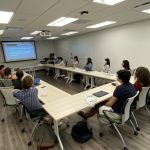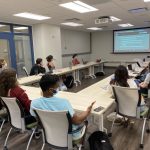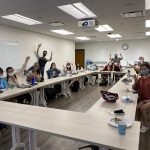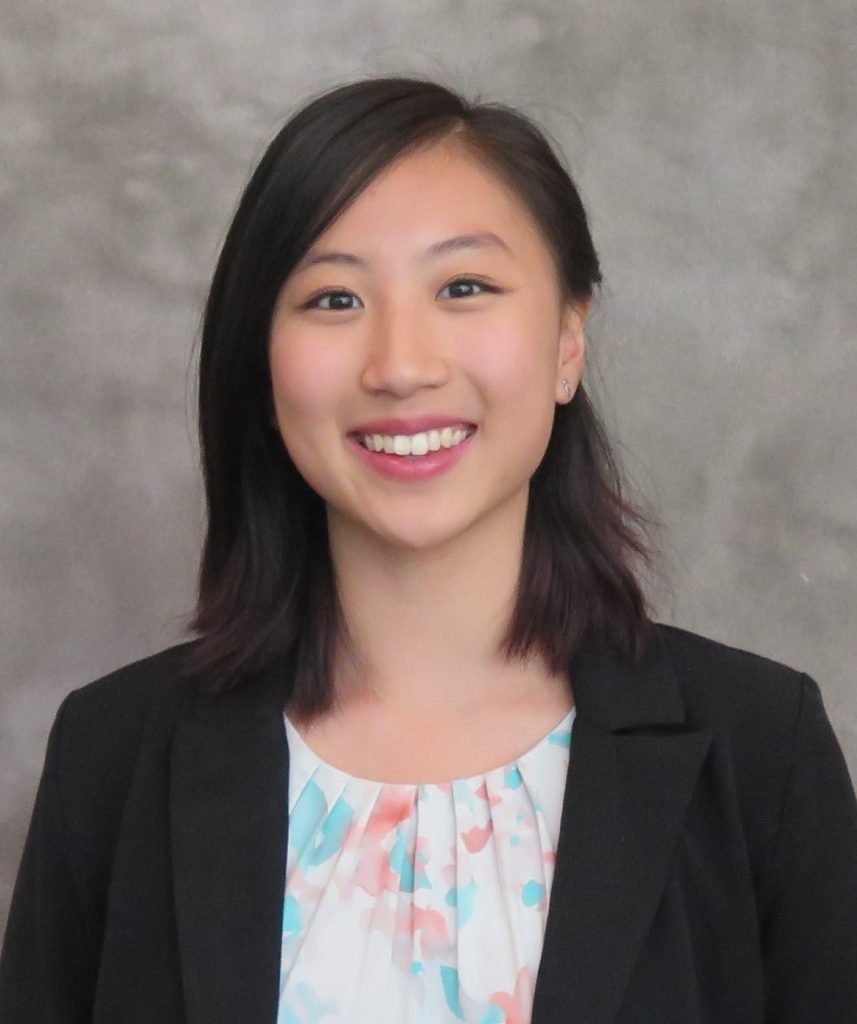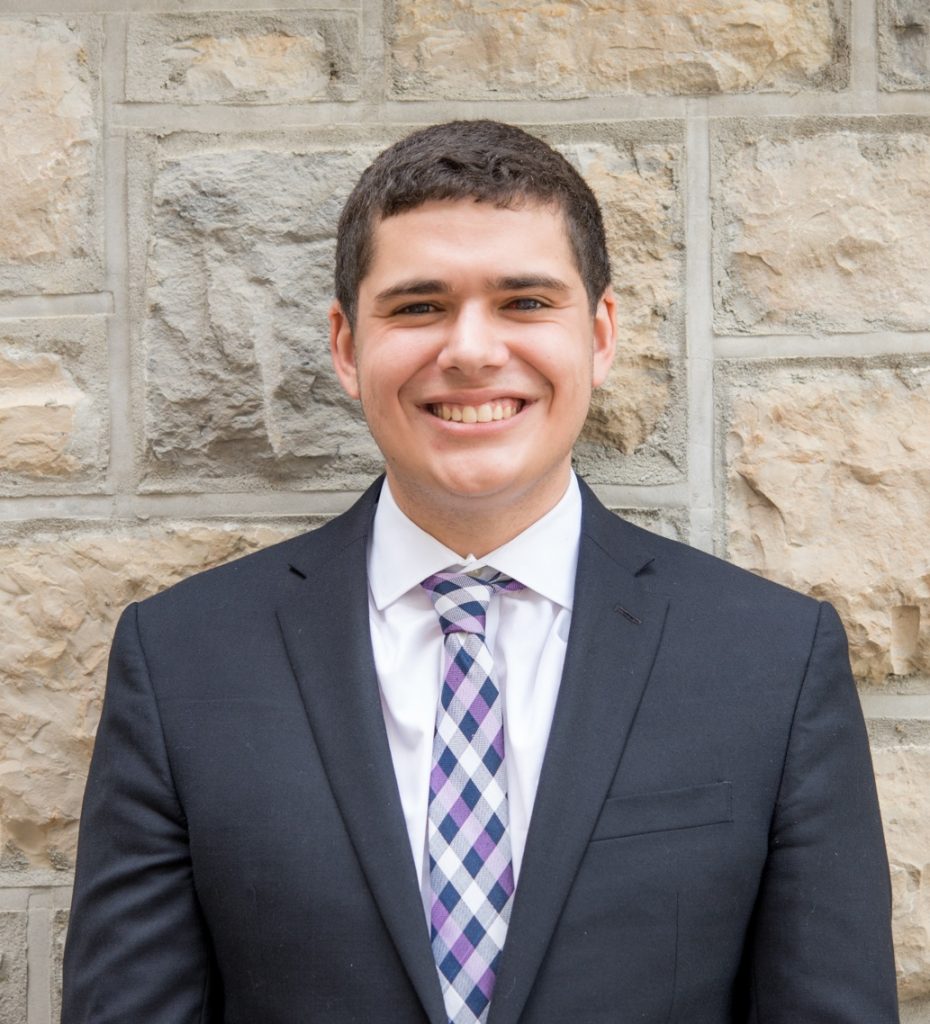This week marks the last week of classes this Spring Quarter before finals week begin. Here’s some snapshot of our lovely Graduate Student and Lab Director teaching the class.
Noshir presents keynote at PLM Road Map & PDT Spring 2021
Describing how professionals can learn from NASA’s research on assembling a mission-critical team for space travel, Noshir Contractor recently presented a keynote titled “Designing and Keeping Great Teams. Lessons from Preparing for Mars. What Can PLM Professionals Learn from This?”
KEYNOTE: Designing and Keeping Great Teams. Lessons from Preparing for Mars. What Can PLM Professionals Learn from This?
Cooperation is critical in space, and NASA has identified important traits for successful teamwork in anticipation of an upcoming Mars expedition. To help assemble a team for the three-year mission, NASA is working with researchers to develop a predictive model of group performance, one which anticipates conflicts and communication breakdowns based on personality traits. PLM conference presentations often mention the dependency on technology, people, and processes for success, but mostly focus only on the technology. The introduction of disruptive technologies puts even more pressure on the people aspect. This presentation will share research findings on assembling a mission-critical team for space travel that might well apply to setting up your mission-critical team for a multi-year PLM implementation.
For more details, please refer to the agenda: https://www.cimdata.com/en/education/plm-conferences/plmrm-pdt-spring-2021/agenda
citation:
Contractor, N. (May 20, 2021). Designing and Keeping Great Teams: Lessons from Preparing for Mars – What can PLM Professionals Learn from This? Keynote address at the PLM Road Map & PDT Spring 2021, Virtual.
Contractor’s Virtual Visit to the University of Minnesota’s Department of Industrial and Systems Engineering (ISyE)
On Wednesday (04/28), Professor Contractor presented a talk on “People Analytics: Using Digital Exhaust from the Web to Leverage Network Insights in the Workplace” during his virtual visit to the University of Minnesota’s Department of Industrial and Systems Engineering (ISyE).
Contractor delivers keynote at CMSTW’21
Sharing insights from our current work, Noshir Contractor recently presented the keynote “Emerging Communication Architectures and the Changing Nature of Work” at The 9th International Conference ‘Сomparative Media Studies in Today’s World’ (CMSTW).
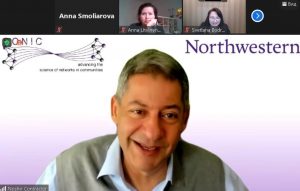
For more info about the conference: http://cmstw2021.org
Call for Papers and Abstracts for our Workshop at the 13th ACM Web Science Conference
Call for Papers and Abstracts:
==========================
The Near Future of Work: Supporting Digital and Remote Collaboration in COVID and Beyond
A Workshop at the 13th ACM Web Science Conference (WebSci 2021)
June 21st or June 22nd
https://sites.northwestern.edu/nearfutureofwork2021
The COVID-19 pandemic has provided us an opportunity to participate in a global “beta-test” of web-only-based remote work. The workshop will reflect on the changing nature of work, identify factors that explain these changes, and how we can learn from the “new” normal to prepare for a better “next” normal. By doing so this workshop seeks to facilitate multidisciplinary dialog as well as theory and research examining challenges and opportunities stemming from digital and remote work on the Web. Topics relevant to this workshop include, but are not limited to: remote work, virtual teaming, enterprise social media (ESM), computer-supported cooperative work, digital platforms, human-AI teaming, work in the gig economy, crowdsourced labor, work-life balance in the digital age, the well-being of remote workers, and workplace communication technology. We especially welcome findings of remote work and digital collaboration that are relevant in the aftermath of COVID-19 (but not necessarily relying on COVID-19 related data).
Important Dates:
================
- Full papers – Submission deadline: April 23rd , Camera-ready papers: May 16th
- Abstracts for lightning talks – Submission deadline: May 17th
Our research on crew dynamics is featured in Sciworthy!
Sciworthy features Professor Contractor’s research on crew dynamics in a long-distance space exploration presented at the American Association for the Advancement of Science (AAAS) Annual Meeting. Are you wondering what actually happens when astronaut teams don’t get along? Click here to read the article and find out!
5 presentations at #SIOP21?!?! What a blast!
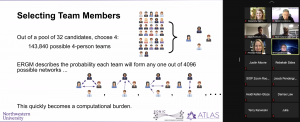
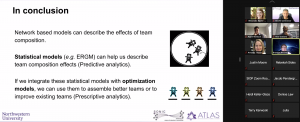
SONIC Faculty Affiliate will also attend #Networks2021
Excited to share that our SONIC Faculty Affiliate Moses Boudourides has 4 abstracts accepted at #Networks2021! Congratulations to authors Mark McGown, Maryam Khalili, Yasmin Abdelghaffar, and Moses Boudourides.
For more info about Networks 2021, click here.
For more info about our abstracts, please see below:
Networks of Co-Occurring Proper Nouns in Anne Frank’s Diary
Authors: Moses Boudourides and Mark McGown
This work aimed to examine Anne Frank’s ‘The Diary of a Young Girl’ (Bantam Books 1994) from the perspective of network science. Data was first collected from The Internet Archive as a raw text file, and sentiment as well as proper nouns were extracted using the NLTK and spaCy libraries in Python. The relationships of sententially co-occurring proper nouns in the overall text were then compiled and analyzed using the NetworkX library in Python. Community partitioning, assortativity analysis, ego-centric subgraphs, cliques, and centrality indices of the networks of proper nouns were studied in order to discover the structural entanglement and clustering of co-occurrent terms. Communities were discovered amongst these proper nouns that showed correlation with the relationships between them. Significant shifts in sentiment both between community partitions as well as temporally were found. The role of each proper noun was found to correlate with its relative ranking in specific measures of centrality. This analysis suggested that data science and network analysis are adept tools at aggregating meaning from text documents. The findings of this project would be of interest to scholars of the humanities and digital humanities, data scientists studying text mining and text analytics, social scientists and psychologists working on biographical narrative interpretive methods, and historians of WWII intellectual and social events.
Networks of affect in COVID19 positive subreddit posts
Authors: Moses Boudourides and Maryam Khalili
Our aim is to explore from both data- and network-analytic point of view the dynamics of affect developing in posts in the COVID19positive subreddit. We have been collecting threads of discussions on this subreddit from the date that they have started appearing on March 14 until October 2020. From these discussions, using standard techniques of NLP of POS tagging, we were able to extract verbs in stemmed form. Based on the essential principles of linguistics, we were partitioning verbs into four socio-linguistic categories: action, doxastic, emotive and sensory verbs. Our research hypothesis is that the strongly affective features of the discourse developed in social media around the current COVID19 pandemic entail an increasing use of verbs in the categories that we are focusing. Moreover, these verbs appear to co-occur in sentences the sentimental (analytic) score of which tends to increase as the current situation happens to aggravate even more. For this reason, we are studying temporal (longitudinal) networks of sententially co-occurring verbs in the COVID19positive subreddit in order to trace the discursive ways in which feelings, concerns, opinions and emotions are embroiled, discussed and unfold the experiential narrative of the pandemic inside social media.
The Role of Media Susceptibility in a Model of Influence on the Ideology of Actors in Social Networks
Authors: Moses Boudourides and Yasmin Abdelghaffar
We are considering here a model of social influence based on interactions between people and media. In particular, we are considering a bounded-confidence model, which consists of media and non-media actors being nodes of a directed graph such that each node was assigned an ideology, as a real valued number in a given interval. At each time-step, the ideologies of non-media nodes would be updated based on their interactions with other media and non-media nodes. The concept of media susceptibility is introduced, a parameter that controls how much influence a node receives from media and from other non-media nodes, with the extremes being that nodes are either not influenced by media, or not influenced by other non-media nodes. Using the number of steady states as a metric for the polarization of the network, we have demonstrated that the more individuals relied on media, the greater the polarization effect within the network.
Mixing and Segregation of Authors’ Gender, “Culture” and Open Access in Publications on Digital Humanities from 2000 to 2020
Authors: Moses Boudourides
The aim of this contribution is to stress the significance of measuring the inhering structural mixing that exists in heterogeneous networks. I will do this over a bibliographic dataset extracted from the Web of Science (WoS), which consists of publications in the topic of Digital Humanities (DH) from 2000 to 2020. The basic methodological orientation in my study is focusing on temporal (longitudinal) bipartite hypergraphs with vertices being various fields (columns) extracted from a bibliographical dataset. Working on the co-authorship network (but also on other dual networks, like the co-publication network, the co-research-area network and the word-net of keywords in the publications abstracts), I intend to determine the way and the extent of how homophily/assortativity/segregation or mixing/disassortativity/desegragation of certain attributes (like authors’ gender, publications’ research areas and Open Access type) are structuring the patterns of academic publishing on Digital Humanities.
Welcome to SONIC, Megan & Brian!
Accepted to Networks 2021!!!
For more info about Networks 2021, click here.
For more info about our abstracts, please see below:
Knowing is not Enough: How Network Awareness and Acuity are Associated
Authors: Kyosuke Tanaka, Leslie DeChurch, and Noshir Contractor
Abstract:
Network research has shown that accurate awareness of a social network brings network advantages (e.g., informal power, faster promotion, and higher performance) to members in groups and organizations. This is because it assumes that those who accurately perceive ties among others within their social network (i.e., high network awareness) can also navigate the social world with more precision, which we call network acuity. However, it is unclear whether this assumption holds true or it is the other way around—network acuity impacts network awareness.
Here, we tested this assumption using cross-lag panel modeling on longitudinal network data from a laboratory experiment where 405 participants (57% female) who were in 23 pre-existing networks engaged in five rounds of a three-minute network routing task. The network routing task was developed based on the notion of Milgram’s small-world experiment where participants within a group select a fixed number of contacts and route messages via these contacts to get them to the target person. We measured network acuity as an individual-level metric of the proportion of times the individual used the shortest path contact toward the target person per round. Each group was randomly assigned to either a workload available condition or non-available condition. In the workload available condition, participants were able to access their contacts’ workload (the number of messages waiting in their inbox to be routed). We hypothesize that the availability of this information impacts how they perceive and use their contacts. We also asked participants to report their perceptions of whom others chose as their contacts to route messages in each round. We measured network awareness based on their accuracy of the actual routing network. Additionally, we collected self-report surveys about their pre-existing social network ties within their group as well as their individual characteristics (e.g., the Big Five personality traits, self-monitoring, and cognitive ability).
Our results show that in contrast to the aforementioned intuition, high network acuity positively predicts network awareness instead of the other way around. This suggests that effective navigation of their social networks by individuals shapes their accurate awareness of the network. We also find that women and those who are popular in the pre-existing social network tend to be higher on both network awareness and acuity. In other words, both dispositional (gender) and positional (popular in the network) characteristics play a vital role in accurate perceptions and navigation of the network. Further, high conscientiousness and cognitive ability are associated with high network awareness, while high self-monitoring is related to high network acuity. Taken together, our findings suggest that knowing the network structure accurately is not enough for people to effectively navigate the network as needed, especially under pressure.
Network Routing Task Performance among Space Crew with Mission Support in Space Multiteam Systems
Authors: Kyosuke Tanaka, Xiangheng Chen, Aida Baimenova, Leslie DeChurch, and Noshir Contractor
Abstract:
In long-distance space missions, communication delays (CD) between space crews and ground mission control (MC) become longer as crews get farther away from earth, thereby setting a higher demand for effective information sharing under resource constraints. Due to “bandwidth constraints,” space crews and mission support need to leverage their indirect contacts (i.e., contacts’ contacts) to route information optimally. The lack of awareness of one’s network contacts could result in failure of information sharing, contributing to the risk of accidents during space missions. However, what factors play a role in predicting such awareness has not yet been studied.
Here, we introduce the concept of network acuity to characterize the individual’s ability to effectively use the network awareness as needed. It is measured by the extent to which an individual can identify the direct contact who is on the shortest path to their indirect, destination contact. We collected data from NASA’s Human Exploration Research Analog (HERA), Campaigns 3, 4, and 5, and Russia’s Nezemnyy Eksperimental’nyy Kompleks (NEK) SIRIUS-18/19, using Project RED Relay—a web-based simulation portal that enables space crews and MC to engage in network routing as part of a multiteam system (MTS) task. Each participant was instructed to choose only 2 direct contacts among 11 others (simulating bandwidth constraints) and aim for routing information to destinations with which they were only indirectly connected via the fewest steps. In total, we analyzed 97, 12-member network sessions (81, 4-crew-8-MC sessions for HERA and 16, 6-crew-6-MC sessions for NEK), each assigned with different CD conditions (180-second, 60-second, or zero for HERA and 30-second or zero for NEK).
Our results show that factors, such as CD and the Big Five personality traits, can impact an individual’s network acuity. We found that the network acuity of space crews is significantly higher than that of MC in both NEK and HERA Campaigns 4 and 5, but not Campaign 3. Further, we found a negative relationship between the network acuity and CD in MC members, but such a relationship is not significant among space crews. In addition, our study of the HERA and NEK data shows that space crews’ network acuity was negatively associated with conscientiousness in both Campaigns 3 and 4, whereas it was positively associated with traits of openness to experience, agreeableness, and neuroticism in Campaign 4, but not in Campaign 3. Overall, our results demonstrate the need to consider key personality characteristics in selecting space crews to maximize network acuity. This will be key in mitigating failures in information sharing within multiteam systems (MTS) and the associated risks. We anticipate our study to be a starting point for more research into determining the optimal level of the Big Five personality traits in terms of information sharing, as well as identifying more factors impacting network acuity within MTS under different CD conditions.
Hard to recruit but worth trying: Searching for cross-boundary collaborations in science
Authors: Neelam Modi, Alina Lungeanu, Leslie DeChurch, and Noshir Contractor
Abstract:
“We hail individual geniuses, but success in science comes through collaboration.” (Farrar, 2017)
Research that looks back on collaboration that produced the greatest scientific breakthroughs highlights boundary-crossing collaboration. By boundaries, we mean disciplines, organizations, cultures, professions, and demographics. Although collaboration has long been important in science, the rapid specialization of knowledge across domains is making collaboration essential. This is especially true in biomedical research.
The National Institutes of Health (NIH) makes substantial investments to encourage cross-boundary team science in biomedicine. This research project focuses on an exemplar support mechanism, the NIH’s Clinical and Translational Science Award (CTSA) Program. With a $500 million annual budget, the CTSA Program is designed to facilitate collaborations between the “(laboratory) bench and the (clinical) bedside” as well as streamline multi-site studies. In particular, the CTSA’s Pilot Grant program, which provides seed funding to hundreds of teams each year, seeks to incentivize new cross-boundary teams that bring together basic scientists and clinical researchers, junior faculty and experienced mentors, and researchers from different departments or institutions.
While cross-boundary collaboration in team science has demonstrated benefits, research also suggests they are unlikely to form, and when they do, are prone to coordination costs. Our study seeks to advance the Science of Science by understanding the assembly of cross-boundary teams who conduct clinical and translational science. We leverage both social network theories and research on groups and teams to answer two research questions: (RQ1) Do funding investments shift team composition in favor of cross-boundary collaboration? and (RQ2)
Which cross-boundary combinations are the most effective?
To answer these research questions, we use archival data about researchers submitting proposals to one Midwestern University CTSA’s Pilot Grant Program between the years of 2014 and 2019. We examine 432 proposal submissions in total, of which 323 were team proposals (having 2 or more researchers). This results in 288 researchers listed as Co-PIs on team proposals, of whom 243 did not have their proposals awarded, 7 had both awarded and un-awarded proposals, and 38 had awarded proposals. We extract demographics, education and employment information, and organization and department affiliation from the university’s internal database. Additionally, we use publication data from the Web of Science database to construct bibliometric information (including publications, co-authorship and co-citation relations) for the entire population of researchers who submitted grant proposals.
We use Exponential Random Graph Models to assess factors influencing the assembly and success of grant proposal teams. Preliminary results show that in general cross-boundary collaboration are not likely among teams submitting proposals, but cross-disciplinary collaborations are more likely among the team proposals that were successful. Thus, even though cross-boundary collaboration is widely promoted, researchers are more likely to consort within their own demographics. However, in order to be successful, scientists would benefit by collaborating with different disciplines.

